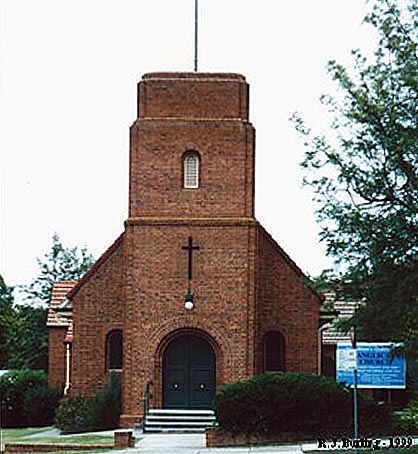
St Alban's Anglican Church, Quirindi
[Photograph by Trevor Bunning (September 2007)]

St Alban's Anglican Church, Quirindi
[Photograph by Trevor Bunning (September 2007)]
Historical and Technical Documentation by Richard Ward
© OHTA 2014 (last updated April 2014)1
The Anglican Parish of Quirindi is the southern-most parish in the Anglican Diocese of Armidale. The Quirindi Parish was created when it was separated from the Gunnedah Parish in 1882, and the first service in the newly-constituted parish was held on 1 November 1882 in the Union Church Chapel. The first St Alban's Church, a weatherboard building, was dedicated by Bishop J.F. Turner on 31 Jan 1886. The present red-brick church, designed by architect Ronald Richardson of Sydney, was dedicated by Bishop W.F. Wentworth-Shields on 11 Mar 1925.2
The organ in the old weatherboard church was built by Mr Arthur Linley Scott [born Ezra Brook and known later as Arthur Scott Brook] of Maitland in 1897. An accomplished organist and conductor, and a native of New Zealand, Scott became organist of St Paul's, West Maitland, in November 1895.3 A description of the instrument appeared in The Maitland Weekly Mercury (4 December 1897), as follows:
A Maitland Built Organ.
Mr. A. L. Scott, organist of St. Paul's, West Maitland, is not only a gifted player, but he has shown himself to be a practical organ builder, as proved by the fine pipe organ which is rapidly approaching completion in the Parish Room, attached to St. Paul's Church. . . . The whole of the instrument has been made in Maitland by Mr. Scott, with the exception only of the manual key-board and the metal pipes. It is being completed as a single manual organ, but every preparation has been made for adding a second manual, which is not at present being inserted on the score of expense. The specification of the instrument as it now stands is as follows: - 1. Open Diapason 8ft., CC to G, 56 pipes (metal); 2. Claribel 8ft., CC to G, 56 pipes (wood); 3. Gamba 8ft., CC to G, 56 pipes (wood and metal); 4. Principal 4ft., CC to G, 56 pipes (metal); 5. Flautina 2ft., CC to G, 56 pipes (metal); 6. Great to pedal coupler; 7. Bourdon 16ft., CCC to F, 30 pipes (wood); giving a total of seven stops and 310 pipes. There are also two composition pedals. Provision has been made for the addition of a swell organ soundboard to contain four stops with two extra couplers. About half of the metal pipes are from the well-known firm of Henry Willis and Son, London, and the other half being made by Mr. Geo Fincham, of Melbourne. All the wooden pipes, to the number of 98, have been made by Mr. Scott. The outside dimensions of the organ are - Width, 9ft ; depth, 7ft; height, 14ft. The front has a most imposing appearance, being composed of the lowest seventeen pipes of the open diapason, thereby being a "speaking front" and not made up of "dummies," as is often the case. In the middle of the front is a row of eleven pipes well up above the head of the performer, while at each side of the front is a "depressed tower" consisting of three large pipes, the two lowest of which are the largest metal pipes contained in any organ in Maitland. The gamba and flautina stops are made of "spotted metal," the former being especially a most delightful stop of its kind. The bellows are of the double-feeder pattern, and give a very copious supply of wind. A prominent feature of the organ are the pedal Bourdon pipes, which speak with much freedom and fullness. The case work is carried out generally in cedar with plain and mottled kauri for the panels, and when varnished will have a very handsome appearance, the spotted panels in the front being very pretty. The open wood work near the top of the pipes will add much to the appearance of the instrument.4
Scott's instrument was purchased by St Alban's, Quirindi, and installed in 1899.5 It gave good service for the next twenty-five years.
When the new church was built in 1925 it was decided to order a new two-manual organ from Whitehouse Bros of Brisbane. The original quote for the organ in February 1925 had been £650,6 but a reduction was obtained by re-using parts of the old organ. The Parochial Council minutes record that the Council decided that "Whitehouse be given an order as per his specification to build a new organ in church with electric blower complete, [using] part of the material of old organ and the price to be £565 for complete job. . . a considerable portion of the casing and many of the pipes [are] in perfect order."7
The Whitehouse Bros ledger simply records "new pipe organ + Blower £565," with the final payment being made on 17 February 1926.8 The organ was dedicated by the Bishop of Armidale, the Rt Revd W.F. Wentworth-Shields, on 14 February 1926. A description of the organ was given in The Quirindi Advocate of the day:
New Anglican organ, beautiful addition to St Alban's Church.
The organ, which will add to the beauty of the church furnishings, is a two manual instrument, electrically blown. The action is tubular pneumatic throughout, with a separate pallet to every pipe. The effect of this is to prevent robbing, and it also ensures perfect speech and repetition, whether the manuals are used singly or coupled. The keys are of finest ivory with ebony sharps. The pedal board is of the latest pattern approved by the London College of Organists of England - radiating and concave, and of the best seasoned hardwood. The sound boards are slideless (sic) and of ample size, made of thoroughly seasoned timber, and treated to resist the climatic changes to which we are so subject in this district. The bellows are of a capacity to ensure copious and steady supply of wind to the pipes, double-leathered throughout and fitted with panels which, when removed, render every portion of the instrument easy of access. The voicing is arranged so as to secure power and accurate balance of tone in full combination, together with purity and delicacy in the soft and solo registers, and has been carried out under the personal supervision of Mr. J. H. Whitehouse, who is accepted as an eminent authority on this particular branch the profession.9
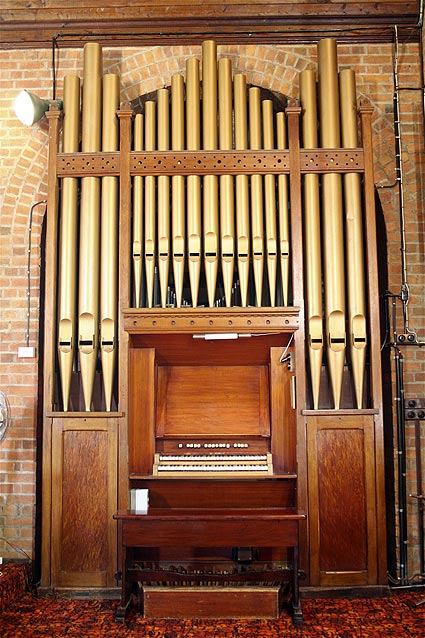
The 1926 Whitehouse Bros organ in St Alban's Church
[Photograph by Trevor Bunning (September 2007)]
The description of the old organ in 1897 (given above) accords with the present arrangement of front pipes, and the dimensions of the case are very close to those given in the original description. It is evident that few changes were needed to the organ case when Whitehouse Bros replaced the single-manual mechanical-action organ with a two-manual pneumatic-action instrument, extended from 56 to 58 notes.
Ian Brown has pointed out that the presence of draw-stop jambs indicates that the case belongs to an earlier instrument. He also noted that the swell has horizontal shutters (which is unusual for a Whitehouse instrument), and previously had a hitch-down pedal.10
This was the second pipe organ supplied to New South Wales by Whitehouse Bros, the first having been at St John's Anglican Church, Tamworth, in 1925. It was followed in the next five years by others for Tamworth, Inverell, Bondi, Armidale and Glen Innes.11
The specification of the Quirindi organ, with supposed derivations from the 1897 instrument, is as follows:
| Great Open Diapason Clarabella Dulciana Principal Swell Gamba Gedact Gemshorn Pedal Bourdon |
8 8 8 4 8 8 4 16 |
[1897] [1897 Claribel] [1897] [marked 8'] [1897] [1897 Flautina re-scaled? Bottom octave cylindrical pipes; other pipes tapered & marked FLAU.] [1897] |
Couplers
Swell Octave
Swell Sub Octave
Swell to Great
Swell Octave to Great
Swell Sub to Great
Swell to Pedal
Great to Pedal
Swell tremulant
Attached stop-key console
Balanced swell pedal
Compass: 58/30
Tubular-pneumatic action
Pedalboard: radiating and concave.12
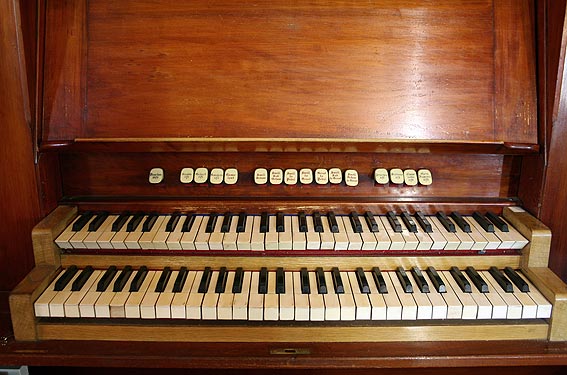
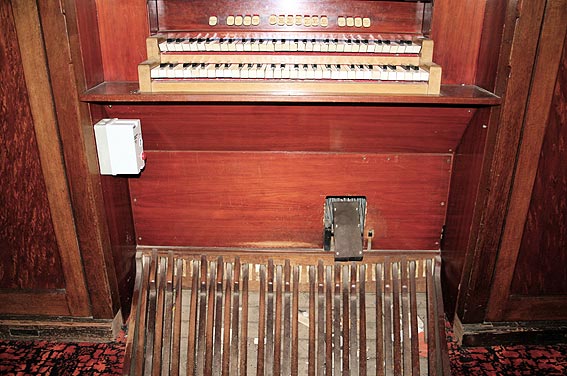
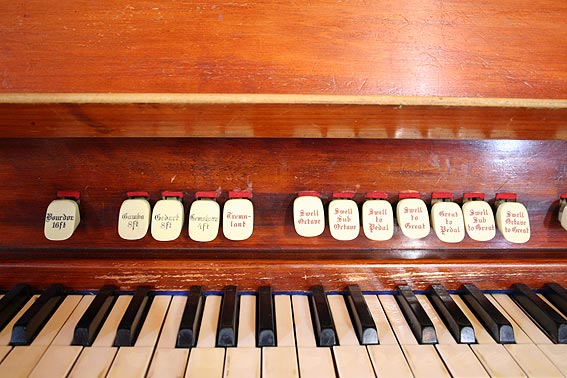
Console details of the Whitehouse Bros organ
[Photographs by Trevor Bunning (September 2007)]
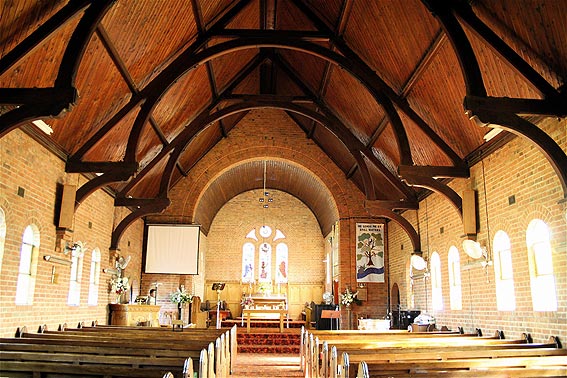
Interior of St Alban's Anglican Church, Quirindi
[Photographs by Trevor Bunning (September 2007)]
__________________________________________________
1. Most of the material presented here was published originally as part of: Richard Ward, 'Arthur Scott Brook: Charlatan or Genius?' The Sydney Organ Journal, vol. 45, no. 2 (Autumn 2014), pp. 21-27.
2. [Church centenary booklet] The Anglican Parish of Quirindi 1882-1982 (privately published, 1982).
3. The Maitland Daily Mercury (7 November 1895), p. 2; details cited in Ward, op. cit., pp. 22-23.
4. The Maitland Weekly Mercury (4 December 1897), p. 16.
5. The Quirindi Gazette (6 Sept 1899 & 20 Sept 1899), cited in Ward, op. cit., p. 23.
6. Minutes of Quirindi Parochial Council (11 Feb 1925).
7. Minutes of Quirindi Parochial Council (9 March 1925).
8. Whitehouse Bros Ledger (1922-1940), p. 109, cited by Geoffrey Cox (March 2014).
9. The Quirindi Advocate (5 Feb 1926).
10. Personal communication to Richard Ward from Ian Brown, 13 November 2013.
11. Graeme Rushworth, Historic Organs of New South Wales: The Instruments, Their Makers and Players 1791-1940 (Sydney: Hale & Iremonger, 1988), p. 207.
12. Specification noted from Trevor Bunning photographs.